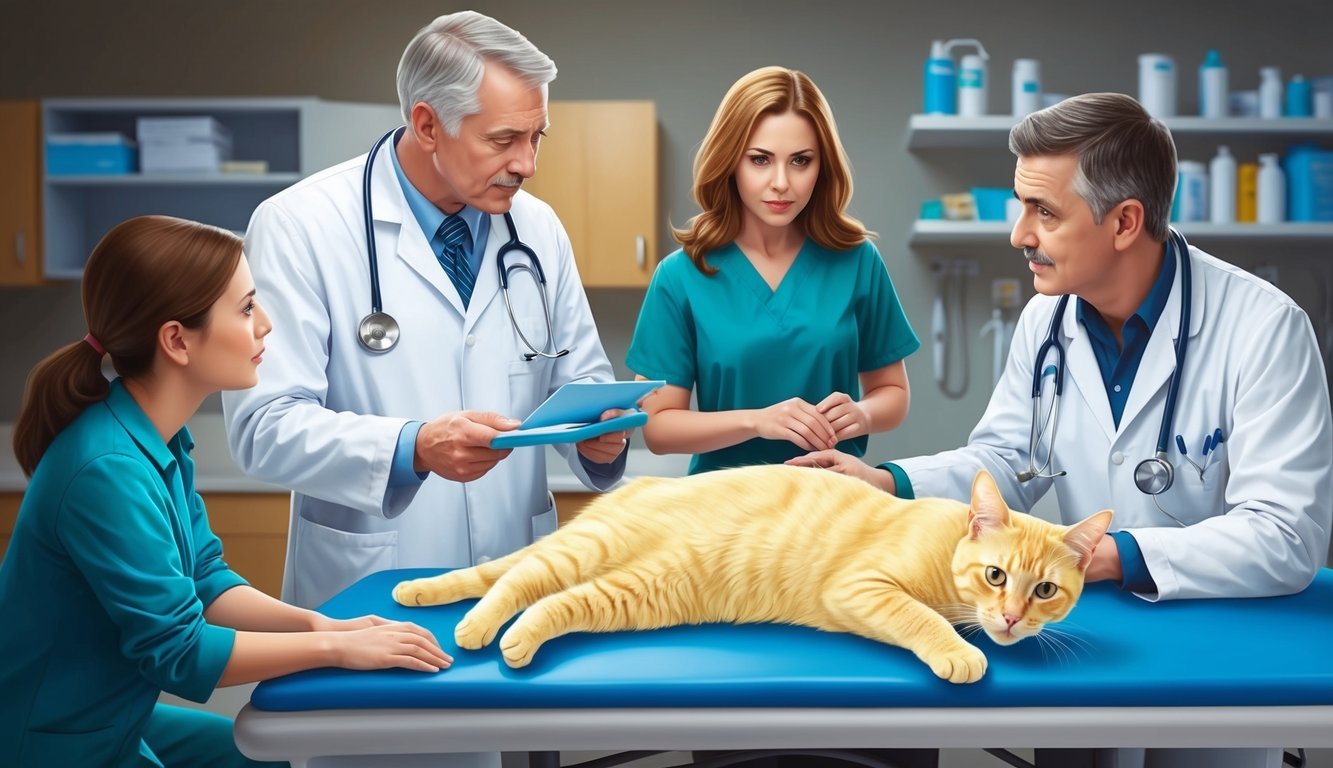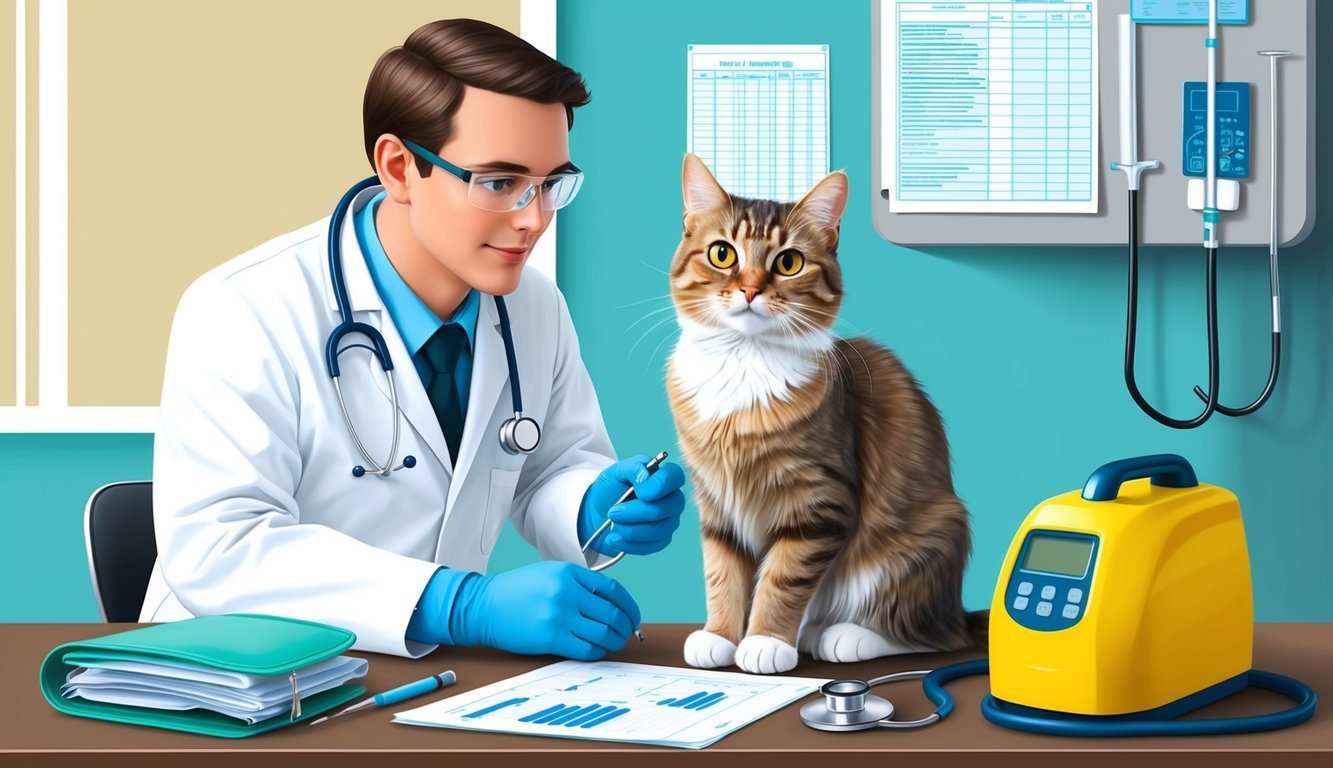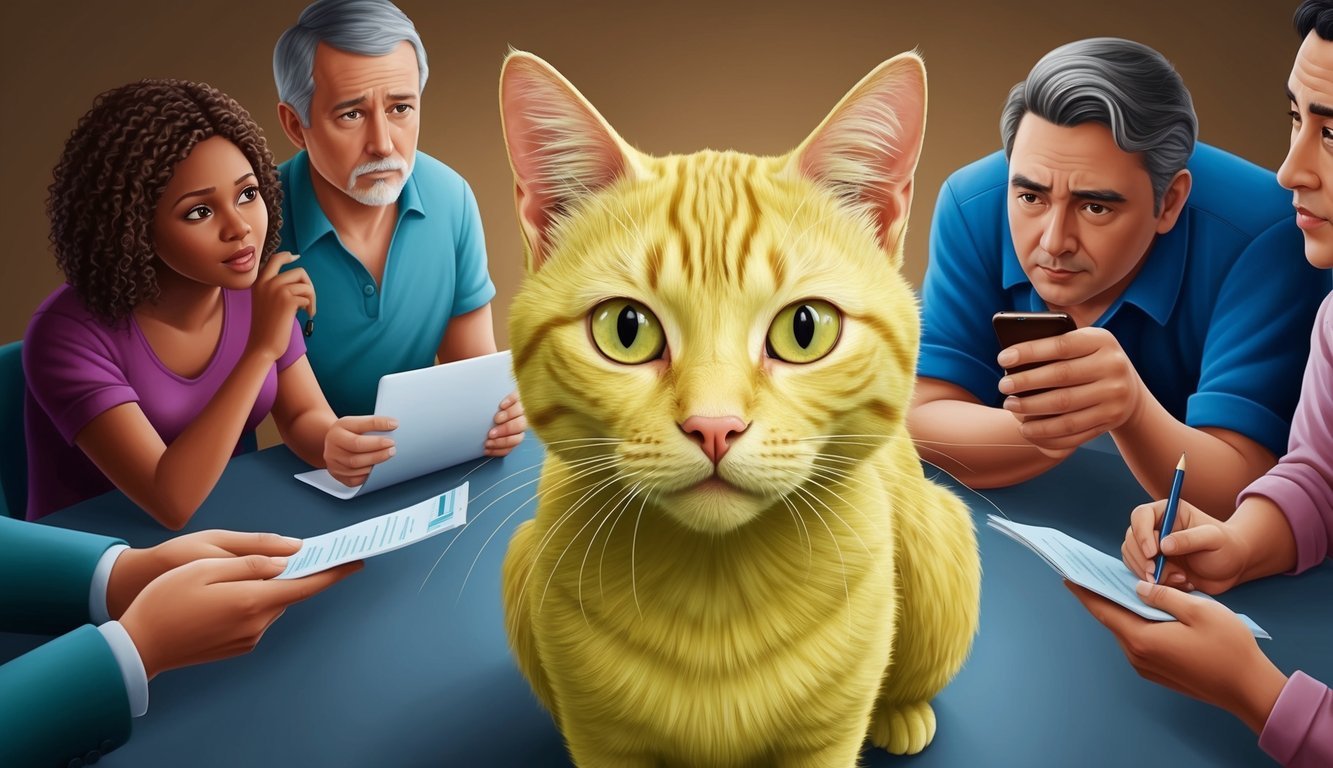Jaundice in cats, also known as icterus, can be alarming for any pet owner.
This condition manifests as a yellowing of the skin, eyes, and gums, indicating elevated bilirubin levels in the bloodstream.
It can signal various underlying health issues, including liver disease, infections, or blood disorders.
Being aware of the signs and prompt action can be crucial for your cat’s health.
Recognizing jaundice early can lead to effective diagnosis and treatment plans.
Symptoms may vary from subtle yellowing to more pronounced changes that could affect your cat’s overall well-being.
If you notice any unusual discoloration or other symptoms, it’s essential to consult a veterinarian for guidance.
Understanding what causes jaundice and how it can be treated will empower you as a responsible cat owner.
Your vigilance can make a significant difference in the health outcomes for your furry friend.
Key Takeaways
- Jaundice is characterized by yellowing of the skin and eyes due to high bilirubin levels.
- Prompt veterinary care is critical for diagnosing and treating the underlying causes.
- Awareness of signs and preventive measures can enhance your cat’s overall health.
Understanding Jaundice
Jaundice is a condition that indicates underlying health issues in your cat.
It manifests as a yellow tint in their skin, eyes, and other tissues due to high levels of bilirubin in the bloodstream.
Let’s explore what jaundice is, its causes, and the different types you may encounter.
What Is Jaundice?
Jaundice, also known as icterus, is not a disease itself but a symptom of various underlying conditions.
It occurs when there is an excess of bilirubin, a yellow pigment produced during the breakdown of red blood cells.
In healthy cats, bilirubin is processed by the liver and excreted through bile.
When this process is disrupted, bilirubin builds up, leading to the yellow discoloration of the skin, eyes, and mucous membranes.
Recognizing jaundice early is crucial.
It often signals liver disease, gallbladder issues, or hemolysis.
Your cat may exhibit other symptoms alongside jaundice, such as lethargy, loss of appetite, or vomiting.
Prompt veterinary intervention is necessary for proper diagnosis and treatment.
Causes of Jaundice in Cats
Various factors contribute to jaundice in cats, primarily revolving around liver function and red blood cell breakdown.
Common causes include:
- Liver Disease: Conditions like hepatitis, hepatic lipidosis, and liver failure can impair bilirubin processing.
- Hemolysis: The destruction of red blood cells can lead to increased bilirubin levels. This can occur due to conditions like immune-mediated hemolytic anemia.
- Pancreatitis: Inflammation of the pancreas may affect liver function, contributing to jaundice.
- Obstruction: Gallstones or tumors can block bile ducts, resulting in post-hepatic jaundice.
Each of these causes requires specific treatment, making it essential to consult your veterinarian for a thorough evaluation.
Types of Jaundice
Jaundice can be classified into three types based on where the problem originates:
- Pre-Hepatic Jaundice: This occurs when there is excessive breakdown of red blood cells, often seen in hemolytic anemias.
- Hepatic Jaundice: This type arises from issues within the liver itself, such as liver disease or hepatic lipidosis, impairing its ability to process bilirubin.
- Post-Hepatic Jaundice: This occurs due to blockages in bile ducts, usually from gallstones or tumors, preventing the excretion of bilirubin.
Understanding these types helps in identifying the root cause and implementing the right treatment approach for your cat.
Always consult your vet for insights tailored to your cat’s specific condition.
Signs and Symptoms
Recognizing the signs and symptoms of jaundice in cats is crucial for early detection and treatment.
These indicators can be broadly categorized into physical indicators and behavioral changes.
Physical Indicators
One of the most noticeable signs of jaundice is yellowing of the skin, eyes, and gums.
This yellow tint occurs when bilirubin accumulates in the bloodstream.
You might also notice yellowing in other areas, such as the inner ears.
In addition, jaundice may lead to a rounded abdomen, indicating possible liver enlargement or fluid accumulation.
If your cat appears lethargic, this is another physical warning sign.
You may also observe symptoms like vomiting or diarrhea.
Other physical indicators include a rough coat and signs of abdominal pain.
Your cat may also show excessive thirst or may drool more than usual.
Pay attention to these symptoms, as they can indicate underlying health issues.
Behavioral Changes
Behaviorally, jaundice can manifest as a marked loss of appetite.
You might see your cat avoiding food altogether or nibbling less than usual.
This can lead to weight loss over time, signaling a serious problem. Fatigue is another behavioral change; your cat may seem more tired or disinterested in activities they once enjoyed.
In some cases, your cat may show signs of fever.
This change in energy level can accompany increased restlessness or irritability.
Look for changes such as decreased activity or a general sense of malaise.
Observing these symptoms can help you identify when it’s necessary to seek veterinary care.
Diagnostic Process
To effectively diagnose jaundice in cats, a systematic approach is vital.
This involves an initial examination followed by advanced testing to pinpoint the underlying cause of the icterus.
Initial Examination
Your veterinarian will start with a thorough physical examination.
During this process, they’ll look for symptoms such as yellow discoloration of the skin, gums, and eyes.
Noting the extent of these changes helps gauge the severity of jaundice.
The veterinarian will also gather your cat’s medical history and ask about any recent changes in behavior, appetite, or weight.
This information is crucial to understanding potential causes.
Basic blood work, including a complete blood count (CBC), will often be ordered to evaluate overall health.
Key parameters like packed cell volume (PCV), alanine aminotransferase (ALT), and alkaline phosphatase (ALP) levels can reveal liver function and indicate possible issues.
Advanced Testing
If initial tests suggest liver involvement, your veterinarian may recommend further diagnostic testing. Ultrasound is a non-invasive method to visualize the liver and surrounding organs.
It helps identify masses, abnormalities, or fluid accumulation.
In some cases, a liver biopsy may be necessary for a definitive diagnosis.
This involves taking a tissue sample to evaluate for conditions like hepatitis or liver tumors.
Other diagnostic imaging, such as x-rays or abdominal ultrasonography, may assist in identifying problems outside the liver.
Additionally, urinalysis can provide insights into kidney function related to the overall health status of your cat.
Common Health Conditions Related to Jaundice
Understanding the underlying health conditions linked to jaundice is crucial for effective treatment and care of your cat.
Various diseases can contribute to the development of jaundice, and recognizing these can ultimately aid in timely veterinary intervention.
Viral Infections
Viral infections can significantly impact liver function in cats, leading to elevated bilirubin levels.
Two notable viruses are the Feline Leukemia Virus (FeLV) and the Feline Immunodeficiency Virus (FIV).
- FeLV can cause severe immunosuppression, making your cat susceptible to other infections and diseases, including liver issues.
- FIV, similarly, weakens the immune system, which may promote liver dysfunction.
In addition, some viral infections can directly attack liver cells.
Conditions like Feline Infectious Peritonitis (FIP) and calicivirus can also result in liver inflammation and dysfunction.
Liver and Biliary Diseases
Liver and biliary diseases are common causes of jaundice in cats.
There are several critical conditions to be aware of:
- Hepatic Lipidosis: Often seen in overweight cats, this condition involves fat accumulation in the liver, leading to liver dysfunction.
- Cholangitis and Cholangiohepatitis: These are inflammatory diseases affecting the liver and bile duct, often resulting in bilirubin buildup.
- Biliary Obstruction: This occurs when gallstones or other factors block bile flow, causing jaundice.
Other serious conditions such as cirrhosis or bile duct rupture can also contribute to jaundice.
Monitoring your cat for signs of liver distress is essential.
Other Related Conditions
Jaundice can arise from various additional health issues that may not seem directly related.
- Anemia: Can lead to increased bilirubin levels due to the breakdown of red blood cells.
- Pancreatitis: Inflammation of the pancreas can cause secondary liver dysfunction, resulting in jaundice.
- Triaditis: This includes concurrent inflammation of the liver, pancreas, and intestines, further complicating symptoms.
- Toxoplasmosis: This parasitic infection can cause liver inflammation and may lead to elevated bilirubin levels.
Each of these conditions reinforces the importance of early diagnosis and appropriate treatment.
If you notice any symptoms of jaundice, seeking veterinary care is vital for your cat’s health.
Treatment Options
When faced with jaundice in cats, a variety of treatment options exist.
Addressing the underlying causes and providing supportive care is crucial for recovery.
Here’s a closer look at some of the key interventions.
Medical Interventions
Medical treatment for jaundice often involves addressing the specific cause of the condition.
Your veterinarian may prescribe intravenous fluids to combat dehydration and support liver function.
Additionally, antibiotics might be necessary if an underlying infection is suspected.
Medications such as anti-nausea drugs and appetite stimulants can help improve your cat’s eating habits, especially if they’re reluctant to eat due to illness.
In some cases, vitamin K may be indicated if coagulopathy is present, as liver disease can interfere with the blood’s ability to clot effectively.
Regular monitoring and follow-ups with your veterinarian are essential to adjust treatment plans based on your cat’s progress.
Supportive Care
Supportive care forms a critical part of treating jaundice.
If your cat isn’t eating well, consider assisted feeding options, such as syringe feeding a high-quality wet food that provides essential nutrients.
Keeping your cat hydrated is vital, so ensure they have access to fresh water at all times.
If they are unable to drink on their own, your veterinarian may recommend subcutaneous or intravenous hydration.
Anti-emetics can help control vomiting, making it easier for your pet to keep food down.
This comprehensive approach helps maintain stability while the underlying issue is being addressed.
Managing Underlying Causes
The key to treating jaundice lies in managing its underlying causes.
For pre-hepatic issues, such as hemolysis, addressing the specific blood disorder is important.
For hepatic causes, therapies may focus on liver support, dietary management, and in some cases, referral to a specialist for advanced diagnostic tests or treatments.
Post-hepatic jaundice can result from bile duct obstructions.
Surgery or endoscopic procedures may be needed to alleviate blockages.
Understanding the root cause enables targeted treatment, promoting better outcomes for your feline friend.
Prognosis

The prognosis for cats with jaundice varies widely depending on the underlying cause of the condition.
Understanding specific recovery expectations and the importance of monitoring can help you manage your cat’s health effectively.
Recovery Expectations
Cats diagnosed with jaundice can have a range of recovery outcomes.
If the cause is identified early and is treatable, such as liver disease or gallbladder issues, the prognosis tends to be good.
Treatment may involve medications, dietary changes, or more intensive interventions.
In cases where liver function is severely compromised, like with liver cancer or advanced liver disease, the outlook may be less favorable.
It’s crucial to follow your veterinarian’s recommendations for treatment and to have open discussions about your cat’s specific condition and what to expect.
Monitoring and Long-Term Care
Ongoing monitoring is essential for cats recovering from jaundice.
Regular veterinary check-ups will help ensure your cat’s recovery is on track.
Your vet may recommend blood tests to assess liver function and bilirubin levels, providing insight into your cat’s health.
Long-term care often involves dietary adjustments to support liver health, along with medications to manage any lingering issues.
Keep an eye on your cat for any recurring symptoms, such as yellowing skin, loss of appetite, or changes in energy levels, and report these to your veterinarian for timely intervention.
Prevention Strategies

Preventing jaundice in cats involves a combination of good practices and regular veterinary care.
Here are some key strategies to consider:
-
Regular Check-Ups: Schedule veterinary visits at least once a year. Routine blood work can help detect liver issues early before jaundice develops.
-
Dietary Management: Feed your cat a balanced diet tailored to their age, weight, and health needs. High-quality cat food supports liver function and overall health.
-
Avoid Toxins: Keep harmful substances, such as certain plants and chemicals, away from your cat. Pay attention to foods that are toxic to felines, like onions and garlic.
-
Hydration: Ensure your cat has constant access to fresh water. Proper hydration is essential for maintaining liver health.
-
Weight Management: Maintain a healthy weight for your cat. Obesity can lead to liver problems, increasing the risk of jaundice.
-
Healthy Lifestyle: Encourage playtime and physical activity. Engaging your cat in daily exercises promotes overall well-being.
By implementing these strategies, you can help reduce the risk of your cat developing jaundice and support their long-term health.
Frequently Asked Questions

Jaundice in cats raises many questions for pet owners.
It’s important to understand the causes, treatments, and management options available for your feline friend.
Here are some common inquiries that you might have.
What can lead to the appearance of jaundice in my kitty?
Jaundice can occur due to several underlying issues, including liver disease, hemolytic anemia, infections, or blockages in the bile ducts.
Conditions like hepatic lipidosis or certain cancers can also contribute.
Identifying the specific cause is essential for proper treatment.
Can I administer any treatments to my jaundiced cat at home?
It’s not advisable to treat jaundice at home.
Early veterinary intervention is crucial, as jaundice may signal severe health issues.
Your vet will provide appropriate treatment options based on your cat’s condition.
What’s the likelihood of my cat pulling through after being diagnosed with jaundice?
The prognosis for a cat with jaundice varies greatly and depends on the underlying cause.
Some conditions are treatable, leading to recovery, while others may be more serious.
Your vet will be the best source for specific information regarding your cat’s case.
Besides vet intervention, how can I help alleviate my cat’s jaundice symptoms?
While veterinary care is critical, you can support your cat at home by ensuring they have a quiet and comfortable space for recovery.
Keep stress to a minimum and monitor their hydration and appetite closely, reporting any changes to your vet.
Are there specific diets recommended for cats dealing with jaundice?
A vet may recommend a special diet that’s easy to digest and lower in fat for cats with jaundice.
Such diets can help reduce liver stress and support recovery.
Always consult your vet for tailored dietary advice for your cat’s situation.
Is there a risk of me catching jaundice from my feline buddy?
Jaundice itself is not contagious.
It’s a symptom rather than a disease.
The underlying causes of jaundice may be infectious (like certain viruses), but transmission to humans is rare.
Always take precautions and follow veterinary advice if an infectious disease is suspected.

